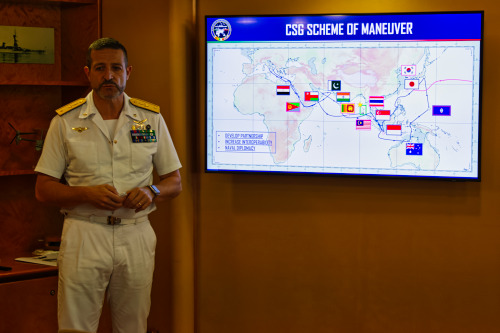On September 21, Alert 5 was invited to visit the Italian Carrier Strike Group at Changi Naval Base, Singapore, offering a rare glimpse into Italy’s growing naval presence in the Indo-Pacific region.
Singapore Visit Highlights
Italian Ambassador to Singapore, Dante Brandi, opened the event on board aircraft carrier ITS Cavour with an address highlighting the purpose of the carrier group’s visit. “This deployment is a testament to Italy’s commitment to strengthening our presence and partnerships in the Indo-Pacific,” Brandi stated. He emphasized the growing Italy-Singapore relations across political, economic, scientific, and cultural domains, underscoring the importance of this naval diplomacy mission.
Rear Admiral Giancarlo Ciappina, commander of the strike group, provided detailed insights into the deployment. The group, which left Italy on June 1st, includes the aircraft carrier Cavour, frigate Alpino and Offshore Patrol Vessel (OPV) Montecuccoli (currently on a separate mission). With an impressive air wing of 15 jets (8 F-35Bs and 7 AV-8Bs) and several helicopters, the strike group boasts about 1,200 Italian personnel plus multinational staff.
Operational Milestones and Capabilities
A key highlight of the deployment was the group’s participation in Exercise Pitch Black in Australia, demonstrating Italy’s commitment to developing partnerships and improving interoperability with allies in the region. “Our presence here is about building bridges and fostering cooperation,” Admiral Ciappina explained.
The deployment marks several operational milestones for the Italian Navy. Notably, the strike group declared initial operational capability (IOC) for its F-35Bs during this mission, signaling a significant leap in Italy’s naval aviation capabilities. Admiral Ciappina detailed the extensive upgrades made to the Cavour to accommodate the heavier F-35Bs, including deck reinforcement and temperature-resistant coating.
The Italian Navy’s transition from AV-8B Harriers to F-35Bs represents a significant advancement in its naval aviation capabilities. This transition is a dedicated effort by the Italian Navy to enhance its operational effectiveness and interoperability with allied forces.
Historic Multi-Large Deck Event with U.S. Navy
Another significant event was when on August 9, the Cavour Carrier Strike Group participated in a historic bilateral exercise with the U.S. Navy. The Abraham Lincoln Carrier Strike Group and the Cavour Carrier Strike Group concluded the first-ever bilateral Multi-Large Deck Event (MLDE) held in the Indo-Pacific by the U.S. Navy and Italian Navy.

The MLDE provided an opportunity for more than 7,500 U.S. and Italian Sailors and Marines to engage in joint operations, including enhanced maritime communication operations, air warfare operations, and cross-deck flight operations. These exercises aimed to strengthen maritime integrated-at-sea operations and combat readiness.
Rear Adm. Adan Cruz, commander of Carrier Strike Group (CSG) 3, emphasized the importance of the exercise, stating, “This was a great opportunity to operate with our close NATO Ally, Italy, in the Indo-Pacific. Our efforts are critical in ensuring a free and open Indo-Pacific region.”
During the event, Admiral Cruz hosted Admiral Ciappina aboard USS Abraham Lincoln (CVN 72) for a visit focused on building interoperability. Admiral Ciappina highlighted the strategic importance of the exercise, saying, “The activity with CSG 3 at sea is an excellent opportunity to enhance our capabilities in Multi Carrier Operations, demonstrating the interoperability of the NATO Alliance worldwide, strengthening our ability to work together and improving our common resilience.”
Participating ships in the MLDE included the USS Abraham Lincoln, USS Spruance, USS Frank E. Petersen Jr., ITS Cavour, and ITS Alpino. The air wing comprised various aircraft from both navies, including F-35B Lightning II jets from the Italian carrier.
Visit to Japan
Following the MLDE and a visit to Guam, the Carrier Strike Group, made its first-ever port call in Japan. Accompanied by ITS Alpino, the Cavour arrived at the Japanese Maritime Self-Defense Force base in Yokosuka, south of Tokyo, on August 22. This visit marked a significant milestone in Italy’s naval engagement in the Asia-Pacific region.
The visit to Japan provided a unique opportunity for the Japan Maritime Self-Defense Force (JMSDF) to observe operations of the F-35B onboard the Cavour. This was particularly relevant as Japan is currently in the process of modifying its two Izumo-class destroyers to operate the F-35B. The firsthand observation of F-35B operations on the Cavour offered valuable insights for the JMSDF as they progress with their own carrier capability development.
This collaboration extends beyond national boundaries, with Admiral Ciappina noting close cooperation with Japanese forces. The shared experience and knowledge exchange regarding F-35B operations and ship modifications underscore the growing importance of international partnerships in naval aviation and maritime security.
The visit not only showcased Italy’s advanced naval capabilities but also strengthened the strategic partnership between Italy and Japan. It demonstrated Italy’s commitment to engaging with key allies in the Indo-Pacific region and its role in contributing to regional maritime security and stability.
Strategic Implications and Future Outlook
The Italian Carrier Strike Group’s deployment, including both the MLDE with the U.S. Navy and the visit to Singapore, represents a significant step in Italy’s new approach to engagement in Asia. While future Indo-Pacific deployments are not currently planned, the success of this mission suggests that Italy’s naval presence in the region may become more frequent as part of its broader strategy of engagement in Asia.
As the Italian Carrier Strike Group continues its journey home, it leaves a lasting impression of Italy’s growing naval capabilities and its commitment to playing a larger role in Indo-Pacific security and cooperation. This deployment not only showcases Italy’s military prowess but also its diplomatic finesse in navigating the complex geopolitical waters of the region.



